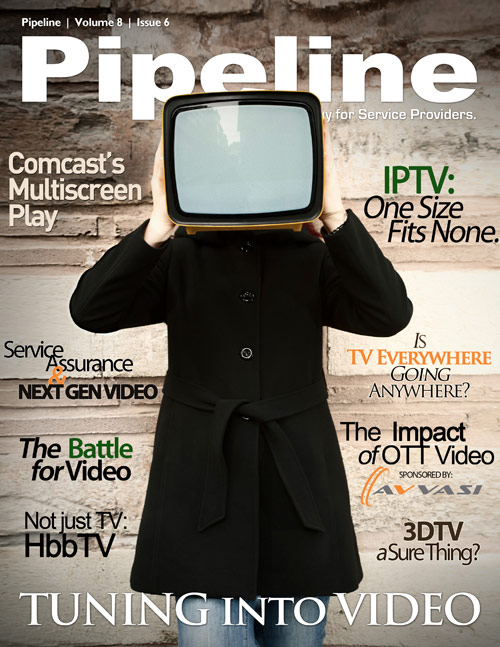Licensing deals with major studios to provide exclusive or first-run distribution of video content have also proven to be successful strategies, but this is an expensive tactic and it doesn't always pay off. Time Warner announced last month that it struck a deal to release Trespass on the same day it launched in theaters. Did you know Trespass stars Nicholas Cage and Nicole Kidman? Probably not, because the movie was a bomb, earning nearly unanimous ridicule on website, Rotten Tomatoes.
One area of content that carriers could focus on and then generate new revenue is exclusive live programming. In the realm of music, some bands are already packaging and selling live concert streams, for $10 to $20 per concert, and currently carriers aren't capitalizing on this market. Another content strategy might be to extend greater personalization to customers, with matching pricing, instead of current “buffet” models that focus on the number of channels available (as if anyone could every stay abreast of 500+ channels of content).
Competitive Strategies
The cheapest paid video service we're looking at in this article—Netflix—has the lowest ARPU and a significant churn rate. In the third quarter of 2011, Netflix ARPU slid to $11.56, and churn climbed to 6.3%. By comparison, Time Warner also passed on price increases to its customer base, and yet boosted ARPU to over $90.
Certainly MSOs should offer multi-screen, on-demand viewing options, but how much money should they spend actively courting customers who are fickle and contribute little to the bottom line? Or is a focus on attracting and retaining high-ARPU, loyal customers a better long-term, strategy? This is an important question that each carrier needs to consider.
On the other hand, Jim Benz of CSG International says it doesn't have to be an either/or situation—it can be both:
In the digital content world, you can go direct to consumers anywhere – not just within your own network footprint. You can deliver services globally; effectively be an over-the-top player yourself. That game is less about ARPU, and more about profitability. Even if you have a low margin, high volume digital content business, you can drive a lot of profit through that line of business to an addressable market of billions of people worldwide. In that case, everyone is fair game. You can use the same infrastructure to deliver and monetize lower quality, lower priced content that is targeted to “lower ARPU” customers as well as high-quality, premium content to “high ARPU” customers. In that case, it’s really more about the direct to consumer model and being able to deliver content globally to any kind of device and do so profitably at a range of price points.
Some service providers are innovating in other ways in order to monetize their assets. While most MSOs have squared off against OTT, Cox Communications moved the opposite direction, and licensed its VOD content catalog to TiVO's Premier set-top box. This means Cox content will sit alongside offerings from Amazon, Netflix, and YouTube.
Verizon has taken the battle for video a step further by launching Verizon Digital Media Services. The carrier has developed an end-to-end “digital media utility,” which is based on the premise that streaming video needs to be transcoded and packaged for delivery. If, say, the Chicago Bears wanted to deliver their own content on demand through a variety of channels, Verizon Digital Media Services could enable and deliver this service. Depending on the customer, this strategy can put Verizon in a position to profit from an OTT offering, even if it's not delivered on the Verizon network. Pretty slick!
Even without Verizon's horsepower, carriers can leverage solutions like CSG International's Content Direct to further monetize their content. Content Direct enables content owners to rapidly launch, scale, promote, and evolve their video assets through multiple channels. It's an innovative solution that enables direct-to-consumer video offerings—something OTT has excelled at. Content Direct also incorporates social media, intelligent advertising, and can deliver video to multiple screens and devices. Similar offerings are available from Cisco (Content Delivery System) and SmithMicro (Vidio).
As a percentage of revenue, video is still king for the cablecos, but it's slipping each quarter, and even though cable has balanced these losses with broadband services, they also must evolve to remain competitive, and that means more screens and innovative partnerships.
Video providers of all types must provide a high-quality video experience across many devices; this is what the digital natives expect in a world of TV everywhere. In terms of price, providers don't need to neglect the low-ARPU customers who flock to OTT, but instead should find ways to leverage their content catalogs with direct-to-customer offerings. Carriers could benefit from offering more personalized content models and integrating with game consoles as well. At the end of the day, multi-screen delivered content, priced correctly and delivered with appropriate quality for the targeted customer base—and there are several—is the difference between a successful video offering and a pixelated failure.








